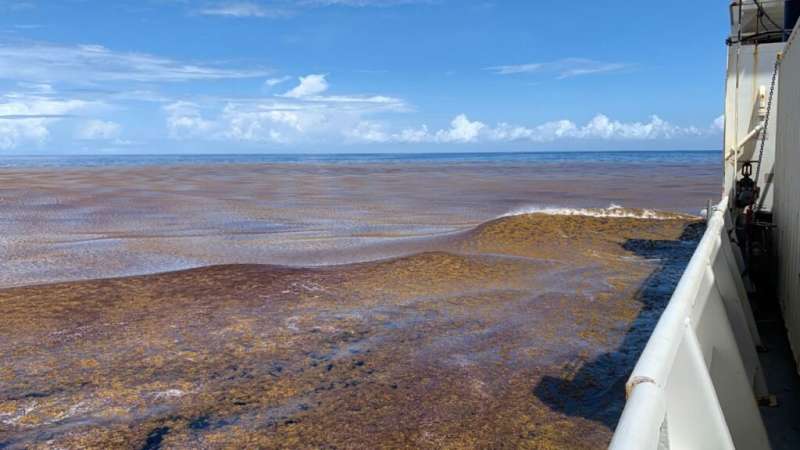Scientists collect samples from Great Atlantic Sargassum Belt during unprecedented bloom

Scientists aboard a U.S. research vessel in the tropical Atlantic are taking advantage of the ship's long-planned path through the to take some of the first samples from a massive, ongoing bloom. Photos and video from the ship show the algae mats on the surface of the eastern Atlantic in the belt that extends from west Africa to the Gulf of Mexico.
This opportunistic sampling is taking place on the National Oceanic and Atmospheric Administration (NOAA) ship, Ronald H. Brown, which set sail from Port Suape, Brazil on March 6 as part of the Global Ocean Ship-based Hydrographic Investigations Program (GO-SHIP). The international program brings together scientists to develop a globally coordinated network as part of the global ocean/climate observing system. The Sargassum sampling illustrates how scientists aboard research vessels can quickly respond to oceanographic phenomena of wide-spread societal importance in real time. "This has been a great way to leverage the measurements we were already making in the region" said Ellen Park, a graduate student who authored a blog on the team's efforts.
Dennis McGillicuddy from Woods Hole Oceanographic Institution (WHOI), along with collaborators Chuanmin Hu and Brian Barnes from the University of South Florida, and Brian LaPointe from Florida Atlantic University, are tracking the Sargassum belt from satellite observations and analyzing these opportunistic samples, with the goal of studying the distribution of different species of Sargassum and measuring their elemental composition to better understand their origin. The nutrient supply feeding these blooms remains enigmatic, and hypothesized sources include upwelling/mixing, atmospheric deposition, and river runoff. These samples can help answer some of these critical questions.
Since 2011, when researchers abnormally large accumulations of Sargassum in the tropical Atlantic Ocean, Caribbean and Gulf of Mexico, the blooms have gotten worse—with substantial economic costs associated with coastal inundation. While the algae support birds and sea life in the open ocean, it can have adverse impacts on environmentally and economically important ecosystems when they reach shore. As it starts to decay, Sargassum emits hydrogen sulfide fumes that impact human health.
Provided by Woods Hole Oceanographic Institution

















